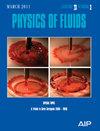Quantification of geometric uncertainty on hypersonic aerodynamics in scramjet inlets
IF 4.1
2区 工程技术
Q1 MECHANICS
引用次数: 0
Abstract
Geometric deviations arising from manufacturing and assembly processes can significantly impact the aerodynamic stability of scramjet inlets. This study aims to quantify the uncertainty and sensitivity of the inlet aerodynamics caused by geometric deviations. Specifically, three representative operating modes are considered: start, half-start, and unstart. Five geometric parameters are extracted as random uncertain variables, including the first and second ramp angle (α1, α2), the horizontal and vertical distance between the lip point and the throat point (dh, dv), and the inner angle of the cowl lip (α3). To achieve the quantification objective, the non-intrusive polynomial chaos method is employed for uncertainty quantification. Sobol indices are utilized to assess the impact of each geometric parameter on the uncertainty of quantities of interest. Results indicate that geometric deviations for only ±1% can have a significant impact on the aerodynamic performance of the inlet. Specifically, the pressure uncertainty in the shock region is more than four times that of the non-shock region, exceeding 40%. With respect to the performance parameters, the mass capture ratio demonstrates a high sensitivity to geometric deviations, with the uncertainty for 6.76%. Sensitivity analysis indicates that the three primary factors affecting the aerodynamic stability within the isolator are dv, α2, and dh. Therefore, deviations in their manufacturing and assembly should be strictly controlled.高超音速空气动力学的几何不确定性量化
制造和装配过程中产生的几何偏差会严重影响喷气发动机进气口的气动稳定性。本研究旨在量化几何偏差引起的进气口空气动力学的不确定性和敏感性。具体来说,考虑了三种具有代表性的运行模式:启动、半启动和非启动。提取了五个几何参数作为随机不确定变量,包括第一和第二斜角(α1、α2)、唇点和喉点之间的水平和垂直距离(dh、dv)以及罩唇内角(α3)。为实现量化目标,采用了非侵入式多项式混沌法进行不确定性量化。利用 Sobol 指数来评估每个几何参数对相关量的不确定性的影响。结果表明,仅 ±1% 的几何偏差就会对进气口的空气动力性能产生重大影响。具体而言,冲击区域的压力不确定性是非冲击区域的四倍多,超过 40%。在性能参数方面,质量捕获比对几何偏差非常敏感,不确定性为 6.76%。敏感性分析表明,影响隔振器内部气动稳定性的三个主要因素是 dv、α2 和 dh。因此,应严格控制其制造和装配偏差。
本文章由计算机程序翻译,如有差异,请以英文原文为准。
求助全文
约1分钟内获得全文
求助全文
来源期刊

Physics of Fluids
物理-力学
CiteScore
6.50
自引率
41.30%
发文量
2063
审稿时长
2.6 months
期刊介绍:
Physics of Fluids (PoF) is a preeminent journal devoted to publishing original theoretical, computational, and experimental contributions to the understanding of the dynamics of gases, liquids, and complex or multiphase fluids. Topics published in PoF are diverse and reflect the most important subjects in fluid dynamics, including, but not limited to:
-Acoustics
-Aerospace and aeronautical flow
-Astrophysical flow
-Biofluid mechanics
-Cavitation and cavitating flows
-Combustion flows
-Complex fluids
-Compressible flow
-Computational fluid dynamics
-Contact lines
-Continuum mechanics
-Convection
-Cryogenic flow
-Droplets
-Electrical and magnetic effects in fluid flow
-Foam, bubble, and film mechanics
-Flow control
-Flow instability and transition
-Flow orientation and anisotropy
-Flows with other transport phenomena
-Flows with complex boundary conditions
-Flow visualization
-Fluid mechanics
-Fluid physical properties
-Fluid–structure interactions
-Free surface flows
-Geophysical flow
-Interfacial flow
-Knudsen flow
-Laminar flow
-Liquid crystals
-Mathematics of fluids
-Micro- and nanofluid mechanics
-Mixing
-Molecular theory
-Nanofluidics
-Particulate, multiphase, and granular flow
-Processing flows
-Relativistic fluid mechanics
-Rotating flows
-Shock wave phenomena
-Soft matter
-Stratified flows
-Supercritical fluids
-Superfluidity
-Thermodynamics of flow systems
-Transonic flow
-Turbulent flow
-Viscous and non-Newtonian flow
-Viscoelasticity
-Vortex dynamics
-Waves
 求助内容:
求助内容: 应助结果提醒方式:
应助结果提醒方式:


